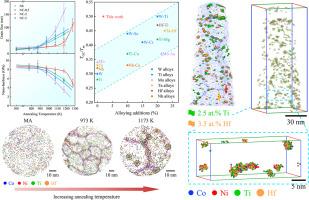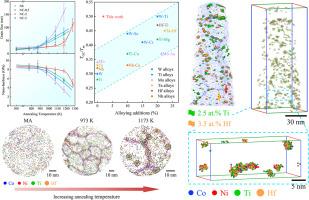通过界面共偏析和聚类稳定纳米晶体
IF 9.3
1区 材料科学
Q1 MATERIALS SCIENCE, MULTIDISCIPLINARY
引用次数: 0
摘要
纳米晶金属通常是亚稳的,易发生晶粒粗化,严重阻碍了其工程应用。抵消这种现象的一个策略是通过晶界偏析来降低晶粒生长的能量驱动力。“隔离越多越好”的自然想法已经被实践了几十年,然而,这并不奏效,因为界面只有有限的装饰容忍度。在此,我们提出通过掺杂多种溶质来解决这个长期存在的问题,这种方法可以在不诱导新相形成的情况下创建热力学和动力学稳定机制的协同组合。这是通过将化学成分的复杂性引入到GB中来实现的,这可能允许通过分离更有效地稳定GB,从而大大降低合金化成本,同时保留nc的原始性能。我们将这种新的设计方法应用于NC-Nb,并表明我们可以将其不稳定温度从873 K提高到1173 K,而合金含量仅为2 at。%的Co, Ni, Ti和Hf以相同的分数。该材料在1173 K下退火50小时后仍保持其纳米晶结构。因此,本工作为开发稳定的稀释数控材料提供了一种有前途的设计策略,可用于先进的工程应用。本文章由计算机程序翻译,如有差异,请以英文原文为准。


Stabilizing nanocrystals via interface co-segregation and clustering
Nanocrystalline (NC) metals are generally metastable and prone to undergo grain coarsening, which severely impedes their engineering application. A strategy to counteract this phenomenon lies in decreasing the energetic driving force for grain growth, through grain boundary segregation. The natural thought of ‘more segregation is better’, which was exercised over decades to solve this problem, however, does not work because interfaces have only limited solute decoration tolerance. Herein, we propose to solve this long-standing problem by doping with multiple solutes, which creates a synergistic combination of thermodynamic and kinetic stabilization mechanisms without inducing formation of new phases. This is enabled by introducing chemical compositional complexity to GBs, which possibly allows more efficient GB stabilization through segregation, thus drastically reducing alloying costs while retain the original properties of the NCs. We applied this new design approach to NC-Nb and show that we can increase its instability temperature from 873 to 1173 K with as little alloying as only 2 at.% of Co, Ni, Ti and Hf with equal fractions. The material maintains its nanocrystalline structure after annealing at 1173 K for 50 h. Therefore, this work presents a promising design strategy for developing stable dilute NC materials for advanced engineering application.
求助全文
通过发布文献求助,成功后即可免费获取论文全文。
去求助
来源期刊

Acta Materialia
工程技术-材料科学:综合
CiteScore
16.10
自引率
8.50%
发文量
801
审稿时长
53 days
期刊介绍:
Acta Materialia serves as a platform for publishing full-length, original papers and commissioned overviews that contribute to a profound understanding of the correlation between the processing, structure, and properties of inorganic materials. The journal seeks papers with high impact potential or those that significantly propel the field forward. The scope includes the atomic and molecular arrangements, chemical and electronic structures, and microstructure of materials, focusing on their mechanical or functional behavior across all length scales, including nanostructures.
 求助内容:
求助内容: 应助结果提醒方式:
应助结果提醒方式:


